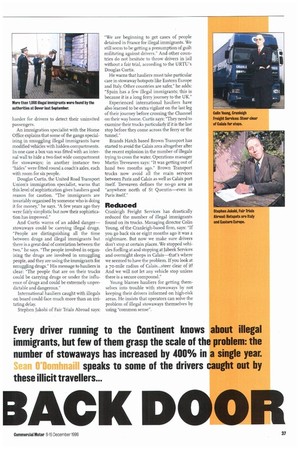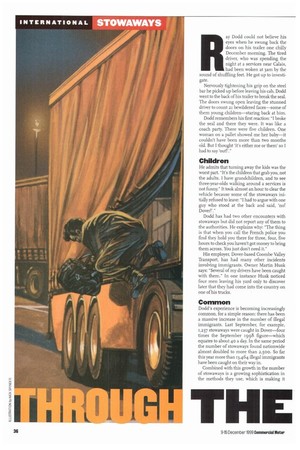Every driver running to the Continent knows about illegal immigrants,
Page 39

Page 38

If you've noticed an error in this article please click here to report it so we can fix it.
but few of them grasp the scale of the problem: the number of stowaways has increased by 400% in a single year.
speaks to some of the drivers caught out by these illicit travellers...
Ray Dodd could not believe his eyes when he swung back the doors on his trailer one chilly December morning. The tired driver, who was spending the night at a services near Calais, had been woken at 3am by the sound of shuffling feet, He got up to investigate.
Nervously tightening his grip on the steel bar he picked up before leaving his cab, Dodd went to the back of his trailer to break the seal. The doors swung open leaving the stunned driver to count 21 bewildered faces—some of them young children—staring back at him.
Dodd remembers his first reaction: "[broke the seal and there they were. It was like a coach party. There were five children. One woman on a pallet showed me her baby—it couldn't have been more than two months old. But I thought `it's either me or them so I had to say 'out!'."
Children
He admits that turning away the kids was the worst part. "It's the children that grab you, not the adults. I have grandchildren, and to see three-year-olds walking around a services is not funny." It took almost an hour to clear the vehicle because some of the stowaways initially refused to leave: "I had to argue with one guy who stood at the back and said, `no! Dover!."
Dodd has had two other encounters with stowaways but did not report any of them to the authorities. He explains why: "The thing is that when you call the French police you find they hold you there for three, four, five hours to check you haven't got money to bring them across. You just don't need it."
His employer, Dover-based Coombe Valley Transport, has had many other incidents involving immigrants. Owner Martin Husk says: "Several of my drivers have been caught with them." In one instance Husk noticed four men leaving his yard only to discover later that they had come into the country on one of his trucks.
Common
Dodd's experience is becoming increasingly common, for a simple reason: there has been a massive increase in the number of illegal immigrants. Last September, for example, 5,237 stowaways were caught in Dover—four times the September 1998 figure—which equates to about 40 a day. In the same period the number of stowaways found nationwide almost doubled to more than 2,500. So far this year more than 13,464 illegal immigrants have been caught on their way in.
Combined with this growth in the number of stowaways is a growing sophistication in the methods they use, which is making it harder for drivers to detect their uninvited passengers.
An immigration specialist with the Home Office explains that some of the gangs specialising in smuggling illegal immigrants have modified vehicles with hidden compartments. In one case a box van was fitted with an internal wall to hide a two-foot wide compartment for stowaways; in another instance two "hides" were fitted round a coach's axles, each with room for six people.
Douglas Curtis, the United Road Transport Union's immigration specialist, warns that this level of sophistication gives hauliers good reason for caution, "The immigrants are invariably organised by someone who is doing it for money," he says. "A few years ago they were fairly simplistic but now their sophistication has improved."
And Curtis warns of an added danger— stowaways could be carrying illegal drugs. "People are distinguishing all the time between drugs and illegal immigrants but there is a great deal of correlation between the two," he says. "The people involved in organising the drugs are involved in smuggling people, and they are using the immigrants for smuggling drugs." His message to hauliers is dear: "The people that are on their trucks could be carrying drugs or under the influence of drugs and could be extremely unpredictable and dangerous."
International hauliers caught with illegals on board could face much more than an irritating delay.
Stephen Jakobi of Fair Trials Abroad says: "We are beginning to get cases of people detained in France for illegal immigrants. We still seem to be getting a presumption of guilt militating against drivers." And other countries do not hesitate to throw drivers in jail without a fair trial, according to the URTU's Douglas Curtis.
He warns that hauliers must take particular care in stowaway hotspots like Eastern Europe and Italy. Other countries are safer," he adds: "Spain has a few illegal immigrants; this is because it is a long ferry journey to the UK."
Experienced international hauliers have also learned to be extra vigilant on the last leg of their journey before crossing the Channel on their way home. Curtis says: 'They need to examine their trucks particularly if it is the last stop before they come across the ferry or the tunnel."
Brands Hatch based Brown Transport has started to avoid the Calais area altogether after the recent explosion in the number of illegals trying to cross the water. Operations manager Martin Treveaven says: "It was getting out of hand two months ago." Brown Transport trucks now avoid all the main services between Paris and Calais as well as Calais port Treveaven defines the no-go area as "anywhere north of St Quentin—even in Paris itself."
Reduced
Cranleigh Freight Services has drastically reduced the number of illegal immigrants found on its trucks. Managing director Colin Young, of the Cranleigh-based firm, says: "If you go back six or eight months ago it was a nightmare. But now we make sure drivers don't stop at certain places. We stopped vehicles fuelling at and stopping at Jabeek Services and overnight sleeps in Calais—that's where we seemed to have the problem. If you look at a To-mile radius of Calais...steer clear of it! And we will not let any vehicle stop unless there is a secure compound."
Young blames hauliers for getting themselves into trouble with stowaways by not keeping their drivers informed on high-risk areas. He insists that operators can solve the problem of illegal stowaways themselves by using "common sense".




































































































